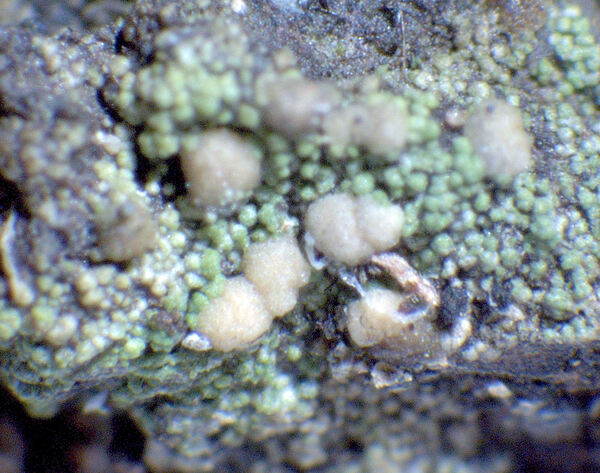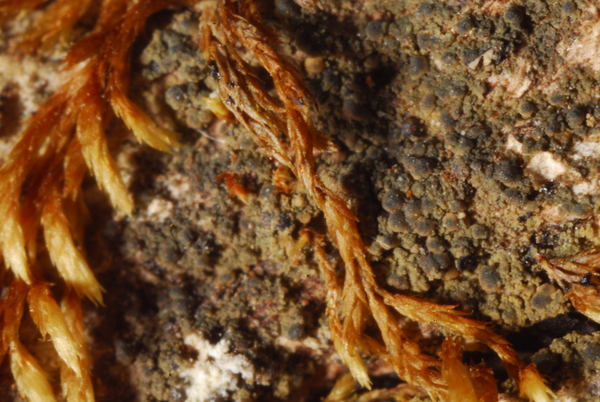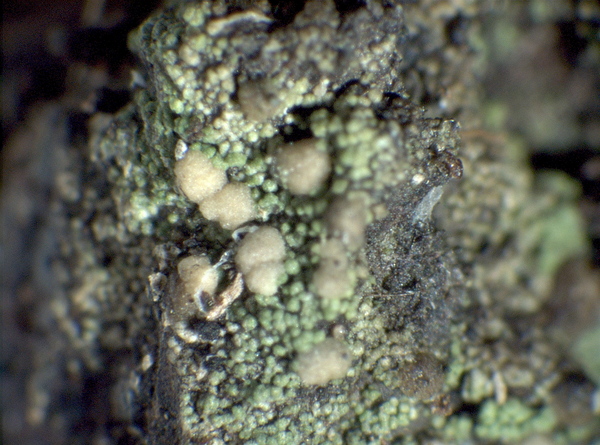Micarea meridionalis van den Boom, Brand, Coppins & Sérus.
Lichenologist (in press) MB 811050, 2016.
Synonyms:
Distribution: C- Laz (van den Boom & al. 2016). S - Cal (van den Boom & al. 2016).
Description: Thallus crustose, episubstratic, effuse, granular, of ecorticate, 0.04-0.1 mm wide, subglobose to irregularly flattened, greenish, greenish grey, brownish grey or pale brown, matt to slightly shiny, up to 20 μm thick areoles which usually coalesce forming a continuous crust or scattered patches; granules soredia-like, mostly thinly coated by gelatinous algae, rarely forming loose, 10-14 μm wide goniocysts. Apothecia micareoid, slightly to moderately convex, beige or pale to dark brownish grey, immersed to semi-immersed amongst the granules and thus seemingly marginate when young, 0.1-0.3(-0.35) mm across, scattered or confluent into tuberculate aggregates, without a distinct proper margin. Proper exciple poorly developed, sometimes distinct in young apothecia and up to 10 μm wide laterally; epithecium olive-green, K+ violet, N+ red; hymenium colourless with pale greyish brown spots, 40-50 μm high, K+ violet, N+ red; paraphyses richly branched, c. 1.2 μm thick, the apical cells up to 1.5 μm wide, not pigmented; hypothecium colourless. Asci 8-spored, clavate to cylindrical-clavate, in K/I with a blue outer layer and apical dome and unstained wall, the dome with an apical cushion. Ascospores 1(-3)-septate, hyaline, ellipsoid, 8-9.4 x 3-4.4 μm. Macropycnidia very rare, c. 50 μm across, colourless except at the grey top, producing 1-septate, slightly curved macroconidia measuring 15-17 x 1.1-1.3 μm. Mesopycnidia frequent, immersed, 50-70 μm across, colourless, producing bacilliform to fusiform mesoconidia measuring 5.8-6.7 x 1-1.2 μm. Photobiont micareoid, the cells, 4-6 μm wide, clustered in compact masses. Spot tests: K-, C-, KC-, P-, UV-. Chemistry: thallus and apothecia with micareic acid; Sedifolia-grey pigment in epithecium. Note: a recently described corticolous species belonging to the M. prasina-complex, with a southern distribution in Europe; it is known from several stations in Portugal, where it grows in ruderal and even dusty situations such as along waysides and in urban parks; the Italian samples are from Pinus along the coast in Calabria, from the Botanical Garden of Rome, and from an open woodland at the periphery of Rome on Quercus suber. For further details see van den Boom & al. (2016).
Growth form: Crustose
Substrata: bark
Photobiont: green algae other than Trentepohlia
Reproductive strategy: mainly sexual
Commonnes-rarity: (info)
Alpine belt: absent
Subalpine belt: absent
Oromediterranean belt: absent
Montane belt: absent
Submediterranean belt: absent
Padanian area: absent
Humid submediterranean belt: absent
Humid mediterranean belt: very rare
Dry mediterranean belt: absent

Predictive model
Growth form: Crustose
Substrata: bark
Photobiont: green algae other than Trentepohlia
Reproductive strategy: mainly sexual
Commonnes-rarity: (info)
Alpine belt: absent
Subalpine belt: absent
Oromediterranean belt: absent
Montane belt: absent
Submediterranean belt: absent
Padanian area: absent
Humid submediterranean belt: absent
Humid mediterranean belt: very rare
Dry mediterranean belt: absent

Predictive model
 Index Fungorum
Index Fungorum
 GBIF
GBIF





